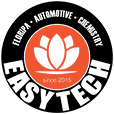Is it worth glazing a car? Many people ask this question because they do not understand what vitrification is and what benefits it brings. So let's clarify this point for point for you.
How to protect car paint?
That is the first and most important question. That's because we have different types of protection that we can put in our car. Who has never put a wax on the car to shine on the weekend? Remember those metal cans that needed the key to open? And the little thing that was inside? How horrible! Then creamy waxes appeared, easier to apply. Today we already have spray wax, paint sealants and even vitrifiers.
What is the difference between these protections?
A carnauba wax is natural, it provides a lot of shine to the surface. However, it is practically liquid protection, since, when subjected to heat, it softens and naturally leaves the surface. It is not a rigid protection and needs to be reapplied frequently. Some waxes have fixing polymers to make certain characteristics such as water repellency more durable.
Paint sealants can be synthetic or hybrid. Synthetic sealants are sealants that use predominantly synthesized substances such as micro-crystalline, oil-derived wax. It has a higher load of fixing polymers to ensure durability. Hybrid sealants usually have carnauba or beeswax in their composition. Sealants are not a rigid protection and last a little longer than natural waxes,
Glazing units are rigid protections whose main function is to increase the original hardness of the varnish, making it more difficult to access the varnish in the event of an impact or a risk. Roughly speaking, the vitrifier was created to “suffer” everything that was previously received directly by the varnish. Among other great benefits, the biggest is the preservation of the varnish in case of need for correction. Damage caused by day-to-day use and degradation by weather agents is absorbed by this protective layer.
How does a vitrifier work?
There are the nano protectors and the resins. Both are called coatings worldwide. In Brazil, we call it a vitrifier. Protective nano form extremely small crystals when dry. It is impossible to form large columns of crystals precisely because of their formation. This avoids cracking of the protection in the event of an impact. The nano coatings need only a good layer to reach the maximum level of hardness and naturally leave a smooth finish on the piece.
Resin glazers form more robust and larger crystals. They usually need more than one layer to reach the maximum level of hardness, they need other products to make the piece soft (which looks heavy) and crackle very easily.
How hard are the vitrifiers?
The products available in Brazil vary from 3H to 9H. This is the graphite scale that measures the risk absorption capacity of graphites. The toughest glazing machine on the national market has a hardness of 9H, like the Insignia 9H from Easytech. The varnish of an automobile has an average hardness of 2 to 3H. By raising the degree of hardness of the varnish, the surface naturally becomes less soiled and scratched. Another very important point is the level of chemical protection of a vitrifier. Considering the Insignia 9H, the strongest product available in the Brazilian market, its chemical protection capacity varies between liquids from pH 2 (highly acidic) to pH 13 (highly alkaline). This protection prevents stains from easily degrading the car's paint surface, which is quite common with the use of unsuitable products.
How to choose the right glazier?
The best choice should be based on the certifications and tests performed with these products. Insignia 9am for example, it is a product that has been tested by SGS, the largest company in the world in terms of measurements, receiving 2 hardness certificates for 2 different types of varnishes. There are few companies that subject their products to rigorous tests like the tests made by SGS because of not only the price but the result. Therefore, a properly certified product is a guarantee of buying a product that delivers what it promises.
Another important point is to seek the evaluation of the specialized media. An example is the MW Insignia, a 1-year-long protective nano that was recently tested by Quatro Rodas magazine in the box “Fulfills what it promises”. The product was applied, tested and approved by Quatro Rodas magazine, lasting exactly the proposed time.
How do I know if my car's varnish is protected?
Watch the video below. The car was fully glazed with Insignia 9H and, a few months later, suffered from limestone contamination from a work carried out in the building where the car was. All vehicles had irreparable damage to the paintwork. The only vehicle that did not suffer any damage was the vehicle protected with Insignia 9H. Considering that a complete repainting of a car costs between 7 and 12 thousand reais, it is very worthwhile to protect the car by applying a good glazing.












